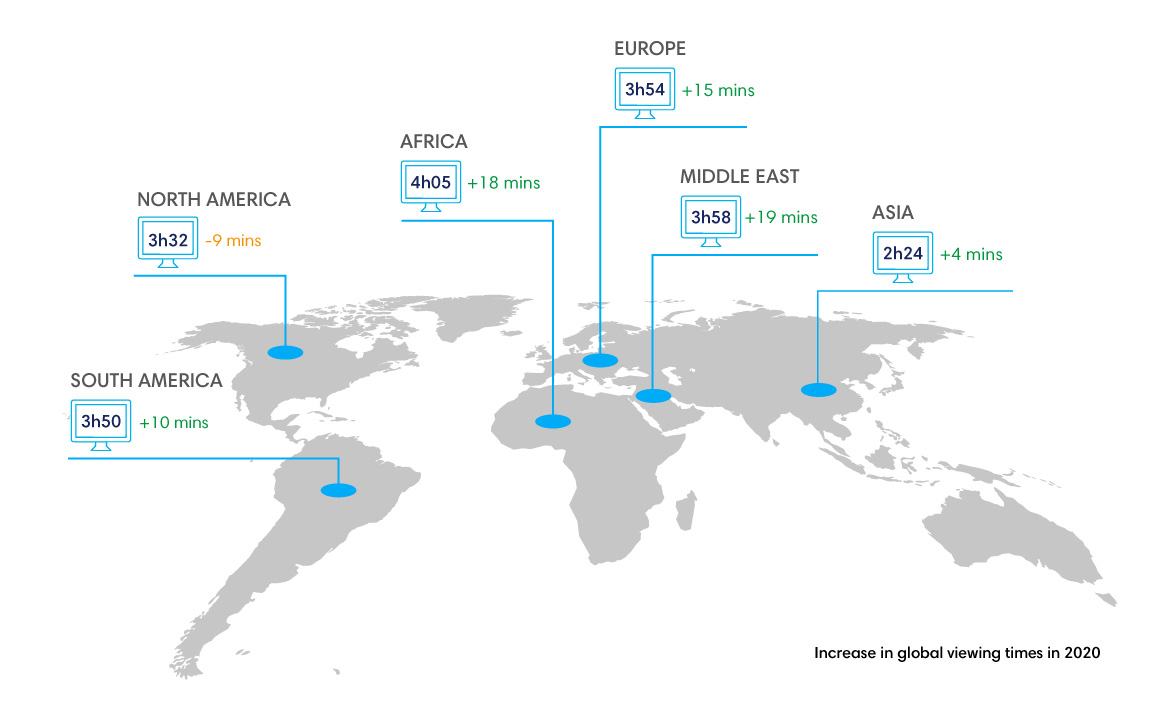Considering the expertise and resources necessary to broadcast global news and large events, the right means of distribution is an important investment for any broadcasting company. However, many broadcasters are neglecting or even abandoning linear TV broadcasting in favour of new services like OTT streaming.
This is a mistake. The two distribution methods actually reinforce each other. By focusing purely on new OTT streaming services and neglecting linear TV, broadcasters risk alienating a large proportion of their customer base. They may lose out on large demographics of new viewers and find it difficult to broadcast certain channels effectively.
In this blog, we’ll look at some of the opportunities of Linear TV for broadcasters, the trends that show its continued relevance and how your investment in Linear TV could pay off.
Linear TV consumption matters
In 2020, global daily viewing time increased across all individuals, according to the One TV Year report. Young adults were viewing 1h49m a day (+2 min from 2019), and there was an average of 2h54m a day (+6 min from 2019).
TV consumption increased in 77% of the 99 territories that were analysed in the report. Compared to 2019, daily viewing times evolved:

When it comes to the type of content that audiences were watching, news and magazine-style genres gained popularity - both growing by 6 points compared to 2019.
The new study for 2021 shows an overall volume of 2h36, i.e., a decrease of 11 minutes compared to 2019. This may partly be due to the aftermath of the pandemic, as people take the opportunity to enjoy previously restricted activities. However, this still significant viewing time confirms the continued importance of linear TV for viewers.
Audience relationships with Linear TV
Across all delivery methods, TV continues to outpace other media for consumer mass reach, and Linear TV continues to be the benchmark of this phenomenon.
By broadcasting a linear channel, you gain access to a wider demographic of viewers no matter your content, target region or size. In Spain, for example, Disney renewed its distribution deal with Vodafone España, giving TV subscribers continued access to a range of linear channels. Despite the content being targeted to young people, a demographic typically associated with streaming, they plan to use the linear channel to deliver more value by increasing its reach to a wider audience of younger underserved viewers. And in Italy, a major OTT player is complementing their streaming service with DTT broadcasting, to increase their reach to more homes across the country.
Linear TV programming is also particularly effective for advertisers as it helps form an emotional connection with audiences due to its predictability and accessibility. In a recent survey by PWC, almost one-third of respondents experienced browser fatigue, often feeling “frustrated” or “overwhelmed” by their streaming services, with one millennial respondent commenting, “With my TV service provider, it’s just easy to put the TV on, sit back and watch. With my streaming service, you have to search and search and search”. This firmly places linear as a top-of-the-funnel medium where advertisers can appeal to the greatest number of viewers possible.
The future of linear TV
The statistics indicate that linear TV will only see a modest decline in the coming years. This is especially true when you consider that news was one of the most-watched content genres. The strength of linear TV lies in reaching wide audiences and broadcasting global news falls into that strength. Live events, such as sports and game shows, also remain particularly popular on linear TV.
Moreover, linear TV is still an avenue for content owners and advertisers as revenues for linear programming in 2024 are forecast to remain over 350 billion Euro worldwide, according to research by IDATE. As such, it will be an easier way to sell to a market that is thriving with viewers who are loyal to your channel, opening the doors for significant growth. In addition, with the reinforcement of digital privacy laws and removal of third-party cookies making it harder to target and measure audiences, advertisers may well move their spend from digital channels to broadcast TV to address audiences.
A partner to your success
Eutelsat understands that making decisions on the future of your broadcasting company is not to be taken lightly. Setting up the business environment to capitalise on Linear TV takes time, resources and technology. We have the experience to help you implement the best way to reach your audiences and ensure the future success of your business.
When it comes to broadcasting, it is essential to reach a wide audience cost-effectively - and Eutelsat can help you with that. Contact us today, and we will guide you through the most effective business strategies, technology and methods to gain a wide audience through Linear TV.



